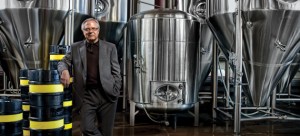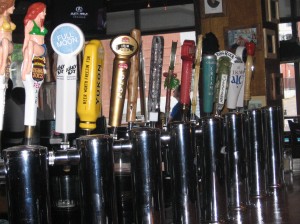Over the summer, Alberta Venture, a monthly business magazine in the province, asked me to write a feature article on the state of craft brewing in Alberta with a particular focus on why Alberta’s microbrewing scene is so much smaller than B.C., Quebec and other provinces. I fancied the idea, as I felt it would give me a chance to more fully explore the business side of the industry. So I spent a few weeks talking with key beer players in Alberta, from micros to pub owners, sales reps to AGLC spokespeople to find out more about the lay of the land.
Did I learn a lot about the beer industry. The article, which is published in this month’s issue (having been bumped a couple of times for more time sensitive stories), focuses on Alberta but I think much of what I found applies to any province or state. It is as much as story about corporate concentration and the lax regulatory enforcement that usually comes with such skewed power structures as it is about beer.
In the article I highlight five causes for the struggles of Alberta craft brewers. First, Alberta has an under-developed culture of localism and artisanal pride. Things made locally are assumed to be lower quality than imports – whether it is beer, films, or what have you. This is not helped by the fact that craft beer got rolling in Alberta AFTER the first big surge of imports, locking in many people to the import scene. Second, Alberta’s requirement of a minimum brewing capacity of 5000 hectolitres makes start up more difficult than elsewhere. Other provinces have no minimum production or capacity limit. Third, the taxation structure, while similar to other provinces on the surface, is not graduated, creating a disincentive to grow past a certain point.
And then there are the practical, on the ground issues. The fourth factor is Alberta’s fully privatized retail system. Despite its upsides, it makes it very difficult for a small player to get wide distribution – requiring a brewery to literally go store-by-store to persuade a retailer to carry their product. This is resource intensive work – and who has more resources?
Fifth, and this is where it gets ugly, there is the widespread practice of “inducements” – offers, gifts, price reductions, free product and favours provided to pubs and
liquor stores to get their business. An industry insider told me the details of the extent of this practice – including purchasing tap lines, providing cash and other expensive items to get a contract. This kind of game, obviously gives the corporate brewers a leg up, as they simply have more cash to spend. The practice is, also – on paper – illegal. but the AGLC operates on a complaint-driven basis, and who the hell is going to complain?
This practice is hardly unique to Alberta. I am told it happens in every province. An article from Chicago recently forwarded to me talks about exactly this in that city. So, it is not the reason why Alberta’s craft beer scene is relatively small, but stack that on top of everything else, and the mountain gets pretty hard to climb.
The topic is not as fun as a beer review, but I am glad I embarked on the project. I hope that readers learn as much as I did about the nature of the beer industry. I am certain many will disagree with my conclusions – especially around privatization and the role of government policy. I am hoping it generates some controversy, as I think it is an issue needing some public air time. Beer, obviously, isn’t nearly as important as health care or education, but it still deserves public policy that is reasonable, fair and balanced.
You can can read the online version here. Or better yet go out and buy the magazine. It is only a few bucks and they are a local Alberta business, too. It also has a sidebar story from me not available on-line. So pick up a copy, open an Alberta-made beer a give it a read.




December 13, 2010 at 9:49 PM
We’re all culpable. If we don’t buy it, they won’t be able to sell it and they’ll get us what we ask for eventually. What is it about north american culture that persuades us to choose such mediocrity when with a little effort we can have flavor and quality.
I’d be interested in knowing what limitations are in place for brew pub operators, not brewer/ distributors since there are so few. Think small and let things grow organically based on demand and word of mouth I say. Maybe that is just not possible given the concentration of mass media persuading us with their messsages.
December 15, 2010 at 3:27 PM
Thank you for exposing the practice of buying bar taps. It happens everywhere even though it is ‘illegal’ and I find it very frustrating, not just as someone who works in the industry but as a consumer as well as I experienced last summer when my favorite pub replaced my favorite local IPA with Strongbow.